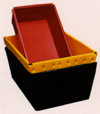
Contact: John Foltz - john.foltz@usa.net
Coroplast Primer

| You've read about it but never seen it? Think again! Coroplast is everywhere,from election signs, to promotional signs at gas stations and supermarkets, to storage boxes. Coroplast is a trademark name of Coroplast Inc. The name is taken from "corrugated plastic." It is also marketed under such names as Corr-x, Plasticor, Hi Cor, and Coroflute. As the name implies, it looks similar to corrugated cardboard except it's made of plastic. To be specific, it is a polypropylene copolymer (other brands may differ slightly in composition.) Think milk jugs and you're close. It's great for outdoor signs because it's weatherproof, stiff, resilient, and resistant to UV and chemicals. As you might guess, most sign shops carry Coroplast; but you can usually do much better with price and selection if you can find a wholesaler. |

Coroplast bins |

Some of the colors available
|
Coroplast fairings are characterized by faceted curves, rather than the true compound curves of a blown lexan or fiberglass/carbon fiber design. Facets aren't as aerodynamically clean as true compound curves, but using narrow Coroplast strips will minimize this effect. To offset this disadvantage, Coroplast fairings can be custom designed for the bike and rider combination. This means it can be set up to fit you exactly, with no unwanted frontal area or missed coverage. The biggest selling point for Coroplast fairings, though, is that they're inexpensive! My front fairings cost about US$40 apiece, compared to $250-650 for a fancy blown lexan one (including frame.) And Lexan scratches easily! Yow! If for some reason you mess up a panel on a Coro fairing, you just pull the piece and cut a replacement. Coroplast also works well for trunks and tailboxes, as well as shipping boxes and even wheel disks. To see some of my coroplast projects, see my projects page. Thanks to Ed Gin, Jeff Potter, and Bill Volk for getting me into this "sickness!" Promotional picture of bins from Coroplast.com |